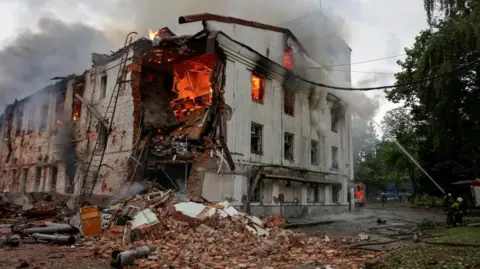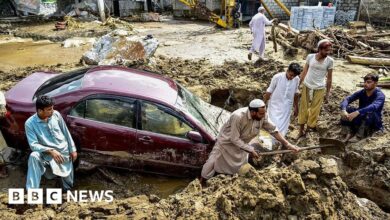Russia launches biggest drone attack on Ukraine’s Kharkiv

Diplomatic correspondent
Russia has hit Ukraine’s second-largest city, Kharkiv, with a massive drone and bomber attack, killing four people and injuring nearly 60, officials say.
Two people were also killed in Russian strikes on Kherson, in southern Ukraine, local authorities said.
Kharkiv Mayor Ihor Terekhov said 48 drones, two missiles and four glide bombs had been used against his city on Friday night, while more glide bombs were reportedly dropped on Saturday.
Earlier, Moscow said a massive wave of drone and missile attacks across Ukraine on Thursday night was in response to “terrorist attacks by the Kyiv regime”, after attacks on Russian railway infrastructure and air bases last weekend.
In another development, Russian and Ukrainian officials released conflicting accounts about when a prisoner swap agreed at earlier talks would happen.
In Kharkiv, some 18 apartment buildings and 13 other homes were hit on Friday night, the mayor said. A baby and a 14-year-old girl were among the injured, he added.
One civilian industrial facility was attacked by 40 drones, one missile and four bombs, Kharkiv governor Oleh Syniehubov said, adding that there might still be people buried under the rubble.
In the later Russian attack using glide bombs on Kharkiv on Saturday evening, one more person was killed and at least another 18 people injured, the city’s mayor said.
Ukrainian Foreign Minister Andriy Sybiha urged allies to increase pressure on Moscow and to take “more steps to strengthen Ukraine” in response to Russia’s latest attacks.
Six people were killed and 80 injured across Ukraine on Thursday night, when Russia attacked the country with more than 400 drones and nearly 40 missiles.
 Reuters
ReutersUkrainian President Volodymyr Zelensky said the strikes on Kharkiv made “no military sense” and were “pure terrorism”.
He accused his Russian counterpart, Vladimir Putin, of “buying himself time to keep waging the war”, and said “pressure must be applied” to stop the attacks.
During the latest round of direct talks in Istanbul earlier this week, the two warring sides agreed to exchange all sick and heavily wounded prisoners of war, those aged under 25, as well as the bodies of 12,000 soldiers.
Moscow’s chief negotiator at the meeting, Vladimir Medinsky, said on Saturday that Ukraine had “unexpectedly postponed both the acceptance of bodies and the exchange of prisoners of war for an indefinite period”.
He further said that the bodies of more than 1,000 Ukrainian soldiers had been taken to an agreed exchange point but that Ukrainian officials had never arrived.
A list of 640 prisoners-of-war had also been handed to Ukraine “in order to begin the exchange”, Medinsky wrote on social media.
Ukrainian officials responded angrily to the allegations, telling Russia to “stop playing dirty games”.
A statement from Ukraine’s Co-ordination for PoWs office said that the comments did “not correspond to reality or to previous agreements”.
The Co-ordination HQ said both sides had been working on preparations for the exchange over the past week and alleged that Russia was not sticking to the agreed parameters of the swap.
It added that Ukraine had submitted its PoW lists according to the “clearly defined categories” of the deal, but that Russia had submitted “alternative lists that do not correspond to the agreed-upon approach”.
While an agreement on the repatriation of bodies had been reached, a date had not been set, Ukraine said, with Russia taking “unilateral steps that had not been co-ordinated”.
Russian air strikes over the past two nights came after bomb attacks on railways in western Russia reportedly killed seven people and injured more than 100, and Ukrainian drone strikes targeted strategic warplanes at four air bases deep inside Russia.
Ukraine’s security service SBU said at least 40 Russian aircraft had been struck during “Operation Spider’s Web” last Sunday.
Ukraine says it used 117 drones that were first smuggled into Russia, then placed inside wooden cabins mounted on the back of lorries and concealed below remotely operated detachable roofs.
The lorries were then apparently driven to locations near the Russian air bases by drivers who were seemingly unaware of their cargo. The drones were then launched remotely.
On Saturday, Ukraine released more footage from that attack – showing a single drone’s entire flight.
US President Donald Trump said on Friday that the Ukrainians had given Putin “a reason to go in and bomb the hell out of them last night”.
He earlier said that during a phone call, Putin had told him “very strongly” that Moscow would “have to respond” following Ukraine’s airfield attacks.
Russia launched a full-scale invasion of Ukraine in February 2022. It currently controls around 20% of Ukrainian territory, including the Crimean peninsula it annexed in 2014 after the overthrow of Ukraine’s pro-Russian president.
Peace talks between the two sides have so far failed to secure a ceasefire, and both sides remain deeply divided on how to end the war, with Ukraine pushing for an “unconditional ceasefire” as a first step, something Russia has repeatedly rejected.
Additional reporting by Jaroslav Lukiv and Vitaliy Shevchenko
https://ichef.bbci.co.uk/news/1024/branded_news/5afa/live/e5d1ce10-43b1-11f0-bace-e1270fc31f5e.jpg
2025-06-07 20:54:53






